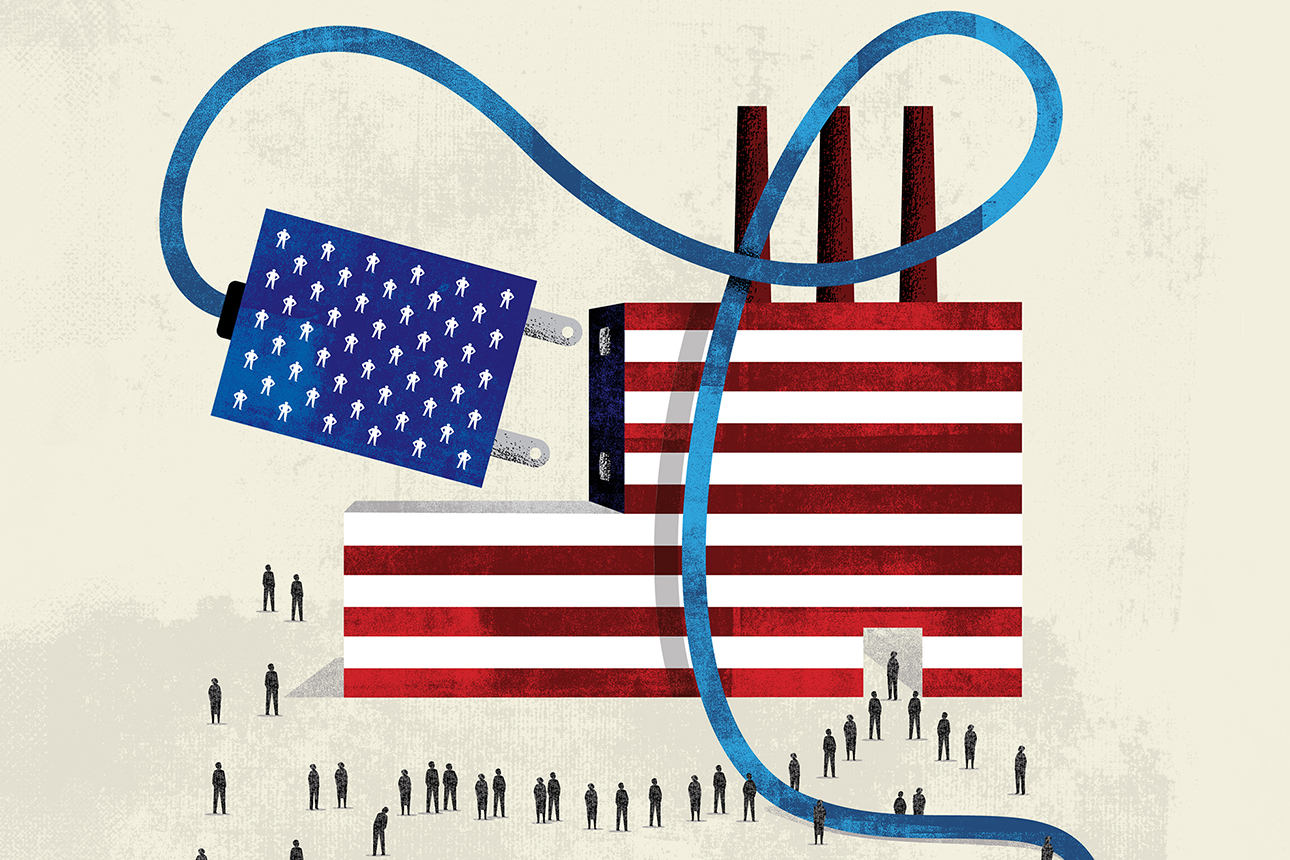Learned a lot lending an editorial hand here:
MIT Sloan Management Review, December 20, 2021
by Christian Stadler, Julia Hautz, Kurt Matzler, and Stephan Friedrich von den Eichen
Michael Austin/theispot.com
Formulating and executing sound organizational strategy is difficult work. Strategy is often made by elite teams and thus can be limited by their biases about competitors, customer needs, and market forces. And it can be an uphill battle convincing stakeholders across the company to channel money, time, and energy in a new and unproven direction.
Our solution to both the strategy formulation and execution challenges is radical: Open up your strategy process. Open strategy offers leadership teams access to diverse sources of external knowledge they wouldn’t otherwise have, while also making individual leaders aware of their biases and helping them build the buy-in needed to speed up execution.
This approach is particularly valuable when companies face disruptive threats and contemplate transformational change. It’s much easier to master disruptions when you’re forging strategy in concert with others who view the world through a different lens than you do. Progress and innovation depend less on lone thinkers with exceptional IQs than they do on diverse groups of people working together and capitalizing on their individuality, as social scientist Scott E. Page has shown.1 In short, diversity of perspective matters — a lot.
Involving people from outside the C-suite — and outside your company — in strategy-making not only provides a wellspring of fresh ideas but also mobilizes and galvanizes everyone involved. Thus, execution becomes an integral part of strategy. The best part: All this can happen without a loss of control over the strategy-making process. Read the rest here
Thursday, December 23, 2021
Open Up Your Strategy
Posted by
Theodore Kinni
at
1:45 PM
0
comments
![]()
Labels: book adaptation, corporate success, strategy
Monday, December 13, 2021
Better management through anthropology
strategy+business, December 13, 2021
by Theodore Kinni
Photograph by Kilito Chan
The next time you hear someone arguing that a liberal arts education is wasted on businesspeople, direct them to Gillian Tett’s Anthro-Vision. In this new book, the award-winning journalist, chair of the Financial Times’s US editorial board, and Cambridge Ph.D. in social anthropology makes a compelling, readable argument for the business value of her academic discipline. Tett finds that this value is delivered in three ways: anthropology makes the strange familiar, it makes the familiar strange, and it attunes awareness when listening for social silence.
“Making the strange familiar”—the quest to understand other people and cultures—goes back to the origins of the science of anthropology in the 19th century (although its main purpose in the early days was to justify “civilized” Western colonialists who were stealing the labor and resources of “primitive” peoples). In 1990, this quest—understanding, not plunder—led Tett to a remote village in Soviet Tajikistan, where she studied marriage rites for her Ph.D.
Making the strange familiar has also led marketers in a global economy to embrace anthropology in their quest to figure out how to sell their products to customers in far-flung markets. The resulting insights can be valuable indeed. Switzerland-based Nestlé’s sales of Kit Kat bars were lukewarm in Japan, until 2001, when marketing executives noticed that sales of the confection surged in December, January, and February on the island of Kyushu. Curious, they discovered that students associated the name Kit Kat with kitto katsu, which means “you must overcome” in the local dialect. The students were buying the bars for luck when they took their exams for high school and university. Nestlé built its Japanese marketing strategy around this insight, and by 2014, Kit Kat was the country’s best-selling confection. Read the rest here.
Posted by
Theodore Kinni
at
8:35 AM
0
comments
![]()
Labels: bizbook review, corporate success, innovation, strategy+business
Wednesday, December 8, 2021
Break Out to Open Innovation

Image courtesy of Daniel Garcia/theispot.com
Mercedes-Benz AG produces over 2 million passenger cars annually for a global market in the throes of transformation. Automakers are meeting new demands for electrification and connectivity, new competitors are arising, and customers have new expectations, such as the desire for sustainable mobility. All of these trends are driving the need to speed innovation in every facet of the automotive industry.
In 2016, R&D and digital business managers at Mercedes’s headquarters in Stuttgart, Germany, realized that their efforts to collaborate with startups — a valuable source of external innovation — were being hampered by the company’s existing innovation processes. Those processes were overly focused on internal development and ready-to-implement solutions provided by the company’s established base of suppliers and weren’t well suited to uncertainty-ridden collaborations with promising technology startups. The company needed an innovation pathway capable of more effectively integrating startups earlier in the R&D process and significantly reducing the time required to identify, develop, test, and implement their most promising technologies and solutions.
In response, a new team within R&D was formed to build a better bridge between the promising ideas of external startups and the innovation needs of Mercedes’s internal business units. The team joined forces with partners from academia and industry to cofound Startup Autobahn, what we call an open corporate accelerator (CA). Unlike a conventional corporate accelerator — typically established by a single company for its own benefit — an open CA welcomes multiple sponsor companies and can attract a broader array of more mature startups. This model, also known as a consortium accelerator, improves sponsor access to external innovation and enhances the overall competitiveness of regional ecosystems...read the rest here
Posted by
Theodore Kinni
at
9:38 AM
0
comments
![]()
Labels: corporate success, entrepreneurship, innovation, partnering, platforms
Tuesday, November 23, 2021
Setting the Rules of the Road
Learned a lot lending an editorial hand on this article:
MIT Sloan Management Review, November 22, 2021
by Ulrich Pidun, Martin Reeves, and Niklas Knust

Image courtesy of Cathy Gendron/theispot.com
The rapid rise of a few powerful digital ecosystems disguises a harsh reality about this business model: Less than 15% of business ecosystems are sustainable in the long run. When we examined 110 failed ecosystems in a variety of industries, we found that more than a third of the failures stemmed from their governance models — that is, the explicit and/or implicit structures, rules, and practices that frame and direct the behavior and interplay of ecosystem participants.
Business ecosystems are prone to different types of governance failures. One reason why the BlackBerry OS lost its competition with Apple’s iOS and Google’s Android was because Research In Motion failed to open its app ecosystem widely to developers until it was too late. Conversely, the video game industry fell into recession during the so-called Atari Shock in the 1980s in part because of overly open access to its ecosystem, which resulted in a flood of inferior games. Badly behaved platform participants, conflicts among ecosystem partners, and backlash from consumers or regulators are other indicators of governance flaws that can bring down an ecosystem.
Many orchestrators struggle to find an effective governance model because managing an ecosystem is very different from managing an integrated company or a linear supply chain. Ecosystems rely on voluntary collaboration among independent partners rather than clearly defined customer-supplier relationships and transactional contracts. The orchestrator cannot exert hierarchical control but must convince partners to join and collaborate in the ecosystem. These challenges are exacerbated by the dynamic nature of many ecosystems, which develop and evolve quickly and continually add new products, services, and members.
Ecosystem leaders who understand the components of a comprehensive governance model and glean insights from ecosystem successes and failures can make more informed and explicit governance decisions. In doing so, they can improve the odds that their ecosystems will be among the lucky few that survive and prosper over the long term. Read the rest here.
Posted by
Theodore Kinni
at
1:33 PM
0
comments
![]()
Labels: business ecosystems, corporate success, platforms
Monday, November 22, 2021
Getting real about DEI means getting personal
strategy+business, November 18, 2021
by Theodore Kinni 
Photograph by Timsa
In her 2019 book, Diversity, Inc.: The Failed Promise of a Billion-Dollar Business, New York University journalism professor Pamela Newkirk reported that, despite billions of dollars spent annually by companies, over decades, to diversify their workforces, little progress had been made. Although racial and ethnic minorities made up 38.8% of the US population in 2019, they accounted for only 4.5% of Fortune 500 CEOs, 9% of US law firm partners, 16% of Fortune 500 board members, 16.6% of US newsroom journalists, and 17% of full-time university professors in the US. Similar inequities—with respect to not just race and ethnicity, but also gender, age, disability, and other factors—have been documented around the world. For instance, the International Labour Organization reports that women participate in the workforce at a rate 26% lower than that of men (and in some places, 50% lower).
The COVID-19 pandemic hit a few months after Newkirk’s book was published, and a few months after that, protests and racial unrest, set off by the murder of George Floyd and lingering outrage over the killing of Breonna Taylor, broke out in cities across the US and around the world. As heated arguments spread into the workplace, diversity, equity, and inclusion (DEI) rose high on corporate leaders’ agendas. They made aspirational promises and set ambitious targets. But will the DEI initiatives launched over the past year produce anything more than slow, small, and easily lost gains?
“Allyship is empathy and action,” Epler, who is CEO of Change Catalyst, a DEI consulting, training, and coaching firm, said in an interview with me. “It’s seeing and understanding the person in front of you, taking the time to listen to their unique experiences, and then taking action to support them in whatever way they need.” This is a prescription for good leadership no matter who is standing in front of you, but particularly for people whose gender, race, ethnicity, age, disabilities, or sexual orientation can leave them isolated in companies. Read the rest here.
Posted by
Theodore Kinni
at
2:39 PM
0
comments
![]()
Labels: corporate success, DEI, diversity, employee engagement, human resources, strategy+business
Tuesday, November 9, 2021
Best Business Books 2021: Taming collaborative dysfunction
strategy+business, November 8, 2021
by Theodore Kinni
Illustration by Serge Bloch
In the 1920s, Mary Parker Follett put forth the heretical idea that managers should pursue power with—not power over—employees. “It is possible to develop the conception of power-with, a jointly developed power, a co-active, not a coercive power,” argued Follett, whom Peter Drucker dubbed “the prophet of management.”
A century later, Follett’s vision is a reality. “Today, practically everything you do at work is a collaboration,” writes Rob Cross, the Edward A. Madden Professor of Global Leadership at Babson College, in Beyond Collaboration Overload, this year’s best business book on the topic of management. “When you attend your morning meeting, when you confer with a direct report, when you help the new person figure out the right expert to speak with about a project, when you page through your emails, when you pause to chat with a colleague, when you move from one webinar to the next while simultaneously addressing instant messages that seem to have urgent time frames—again and again, you’re collaborating.”
If that description seems to be taking on a manic tinge, welcome to the manager’s world. “The collaborative intensity of work has exploded over the past few decades,” writes Cross. Drawing on a series of studies conducted under the aegis of Connected Commons, a consortium of more than 100 large employers, where Cross serves as chief research scientist, he finds that 85% or more of employee time is devoted to collaborative activities. And yet companies have “no idea what impact this time has on corporate performance, individual productivity, or—perhaps most disturbing—employee well-being.”
But Cross has an idea of the impact. Organizational network analysis, performance metrics, and extended structured interviews reveal that many managers collaborate too much—becoming obstacles to organizational performance and their own well-being in the process.
Take Scott, a manager of 5,000 people working in three business units of a large company. In just one of those units, which employed 1,800 people, a staggering 118 people on an average day were going to Scott with requests. Worse, more than 65% of them—78 people—said they couldn’t hit their business goals without more of his time. “This is another obscene number,” writes Cross. “When we see that figure edge up past 25% of a leader’s immediate network, we know we’ve got trouble. Although the leader doesn’t feel it while racing from meeting to meeting, he or she is slowing things down significantly.” The results are burnout, attrition, and lower engagement scores because people can’t get their work done. Indeed, Cross learned that Scott, whom many people in the company considered the leading candidate to succeed the CEO, was about to get fired.
If you’re lucky, your level of collaboration overload is nowhere near Scott’s level. But if you are feeling hard-pressed to keep up with the collaborative demands on your time, and those demands are taking a toll on your performance and well-being, Cross offers succor: he says he can show you (or someone with whom you work or live) how to “reclaim 18 to 24% of your collaborative time”—about one day per week. Read the rest here.
Posted by
Theodore Kinni
at
7:01 AM
0
comments
![]()
Labels: bizbook review, books, management, networking, personal success, strategy+business
Monday, November 1, 2021
Sharing Value for Ecosystem Success
Learned a lot lending an editorial hand here:
MIT Sloan Management Review, November 1, 2021
by Ron Adner
Image courtesy of Jon Krause/theispot.com
What do you call an ecosystem in which you always see your company as the central actor?
An ego-system. This is how we end up with labels such as the “Google ecosystem,” the “Facebook ecosystem,” the “insert-your-name-here ecosystem.” These labels seem impressive at the get-go, but they undermine an important truth: Ecosystem strategy is alignment strategy.
Defining ecosystems around companies blinds everyone involved to alignment hurdles and limits their ability to craft appropriate strategies. The presumption of centrality makes it harder to establish the relationships needed to achieve their goals: It’s harder for ecosystem leaders to create strategies that attract followers, and harder for ecosystem partners to know which leaders to follow and where to place their bets.
Apple offers a stark example. The most valuable company in the world has been enormously successful in extending the mobile data device ecosystem it leads — iPod to iPhone to iPad to Apple Watch, encircled by its App Store and iOS platforms. But it has been shockingly disappointing in its efforts to expand into new businesses that require the construction of new ecosystems. Apple’s failures to deliver on ambitious promises — that health care would be the company’s “greatest contribution to mankind”; that the HomePod would “reinvent home audio”; that its classroom education platform would “amplify learning and creativity in a way that only Apple can” — are concealed by the profits gushing from its core ecosystem, but they are failures nonetheless. The consequences of these failures are borne not only by Apple, but also by all the companies that joined as complementors in these efforts.
If successfully aligning the partners and other participants in new ecosystems is challenging to a company as sophisticated as Apple, a giant at the height of its power, then (1) no would-be market leader should be deluded into thinking that its success in one ecosystem will naturally translate to leadership elsewhere, and (2) no would-be complementor should assume that following established leaders into new domains is a safe bet.
How can all ecosystem players do better? They can anchor their notion of ecosystems in the value propositions that are being pursued, not in corporate identity. This shift in mindset supports the formulation and execution of more successful strategies for leadership (not always the most advantageous role to play) and followership (far more common, but too often neglected) in an ecosystem world...read the rest here
Posted by
Theodore Kinni
at
8:23 AM
0
comments
![]()
Labels: corporate success, ecosystems, platforms, strategy
Thursday, October 28, 2021
People Analytics: A key component to your HR Technology strategy
Learned a lot lending an editorial hand here:
Deloitte Capital H Blog, October 28, 2021
by Jamaal Justice and Albert Hong
The promise of generating actionable insights in every aspect of work, the workplace, and the workforce has created fast-growing demand for people analytics (PA). A myriad of vendors are seeking to meet the demand with an ever-expanding mix of solutions (e.g., tools for Human Capital Management Systems (HCM), data ingestion, data warehouse/lake, extract/transform/load (ETL), business intelligence, and advanced analytics that are evolving as quickly as their underlying technologies.
The explosive proliferation of Human Resources (HR) technology and solutions is a challenge for HR leaders at every step along the PA maturity curve for two principal reasons. First, the ideal set of PA tools and solutions for meeting all organizational needs has not yet emerged. Second, most organizations are still in the process of developing the capabilities needed to evaluate their PA needs: Deloitte’s 2020 High-Impact People Analytics study found that 82% of organizations globally are in the earlier stages of their maturity journey.
Whether HR leaders are in the early stages of building PA capabilities or trying to stay on the cutting edge of what is possible, they need a North Star — a guiding light and a path that will lead them to a strategy and HR technology architecture capable of delivering on the promise of PA across their organizations over time. Read the rest here.
Posted by
Theodore Kinni
at
8:47 AM
0
comments
![]()
Labels: analytics, corporate success, human resources, technology
Tuesday, October 26, 2021
What’s Your Return on Visibility?
Learned a lot lending an editorial hand here:
MIT Sloan Management Review, October 26, 2021
by Michael Schrage

Digitalization driven by COVID-19 has accelerated and transformed management’s ability to track what and how workers are doing. This growth in networked visibility significantly increases the risk of institutional and interpersonal conflict, as well as challenges to cultural norms.
Many workers rationally fear that enhanced monitoring empowers management — and micromanagement — at their expense. When experienced as corporate surveillance, monitoring implies a lack of trust and an invasion of privacy, especially when people are working from home. That’s not sustainable; no one wants to feel spied on. Consequently, if not ironically, leaders are being pushed to make visibility far more visible.
While greater transparency around visibility can allay employee fears, it may also expose and provoke clashes in core values. If the interactions on a distributed work team, for example, are appropriately inclusive, but that negatively affects productivity, what happens next? Workers in general — and remote workers in particular — want credible narratives explaining visibility’s benefits, costs, and trade-offs. Opacity around visibility invites credible accusations of hypocrisy.
Visibility, like capital, compensation, and digital transformation, requires explicit purpose and policies. Leaders, not just HR and IT administrators, should explicitly manage visibility as an enterprise asset. Read the rest here.
Posted by
Theodore Kinni
at
8:39 AM
0
comments
![]()
Labels: articles to ponder, corporate success, data science, employee experience, human resources
Friday, October 15, 2021
A transactional approach to power
strategy+business, October 13, 2021
by Theodore Kinni
Photograph by Metamorworks
Transactional has become something of a dirty word in the business world. It suggests a short-term, one-off mindset and a commoditized approach to value. Nobody wants transactional relationships with employees, suppliers, or customers. But when it comes to exercising power, understanding power as a transaction may be a leader’s best bet.
That’s because power is something leaders are commonly thought to possess, either by force of personality or by dint of positional authority. The mistaken idea that you are inherently powerful can be extraordinarily seductive—and comes with a variety of leadership pitfalls. Hubris (an exaggerated sense of self-confidence) is one of them. Arrogance (the belief that you are smarter than everyone else) is another. Worst of all is omnipotence—the conviction that you are above the rules. From there, it’s only a short hop to becoming living proof of Lord Acton’s famous line, “Power tends to corrupt, and absolute power corrupts absolutely.”
There are lots of worthy prescriptions for avoiding the pitfalls of power, including servant, humble, and empathic leadership. But they depend on a level of self-awareness and mindfulness that can be difficult to muster on a day-to-day basis. If you struggle with the siren call of power, it might be easier to rethink your view of power than to remake yourself.
Organizational behavior professors Julie Battilana of Harvard Business School and Tiziana Casciaro of the Rotman School of Management offer leaders (and followers) such a reframing in their new book, Power, for All: How It Really Works and Why It’s Everyone’s Business. They do it by tapping power dependence theory, a branch of social exchange theory that was developed starting in the 1960s by Richard Emerson, then a sociologist at the University of Cincinnati. Read the rest here.
Posted by
Theodore Kinni
at
7:39 AM
0
comments
![]()
Labels: corporate life, leadership, personal success, strategy+business
Tuesday, September 28, 2021
The Digital Superpowers You Need to Thrive
Learned a lot lending an editorial hand here:
MIT Sloan Management Review, September 28, 2021
by Gerald C. Kane, Rich Nanda, Anh Nguyen Phillips, and Jonathan Copulsky

On Jan. 8, 2020, when Chinese researchers announced that they had identified a new virus that had infected dozens of people across Asia, few business leaders realized that their companies were on the brink of an economic, medical, political, and cultural disruption of global magnitude. In short order, they were called upon to respond to potential illness among employees and customers, supply chain interruptions, dramatic fluctuations in demand, and extraordinarily high levels of uncertainty.
Yet, for all its grim — and ongoing — consequences, the COVID-19 pandemic is just one of many fundamental breaks in the business environment that have challenged leaders over the past 30 years or so. These disruptions come in two forms.
The COVID-19 pandemic is an acute disruption. As with an acute medical condition, the onset of such a disruption is sudden and severe, and its symptoms are obvious. Its treatment calls for a rapid and dramatic response, and its duration is relatively short. The Sept. 11, 2001, terrorist attacks in the U.S., the 2004 tsunami in the Indian Ocean, the 2008 housing and financial crisis, and the 2010 volcanic eruptions in Iceland are examples of acute disruptions.
The second form of disruption is more like a chronic medical condition. Chronic disruptions build slowly. Their immediate symptoms can be subtle and easily overlooked. They require sustained treatment that must be tolerable over time. Chronic disruptions, such as China’s economic rise, climate change, and the evolutionary emergence of digital technology, tend to be persistent and long lasting.
While the two phenomena present differently, they both represent a departure from business as usual to which companies must respond. In studying corporate responses to the pandemic from March through December 2020, we found that companies with existing playbooks for responding to chronic digital disruptions were also responding more quickly and effectively to the acute pandemic disruption. The economic payoffs from digital technologies that allow for enterprise virtualization — such as remote work, e-commerce, and telehealth — increased significantly in the context of COVID-19. Moreover, in responding to the pandemic, many of these companies wound up accelerating their digital transformation efforts and their returns on those efforts.
These companies’ ability to manage the pandemic offers a dramatic illustration of what we’ve come to call the transformation myth. The myth is the idea that transformation is an event with a start and an end during which organizations migrate from one steady state to another, as opposed to a continuous process of adapting to a highly volatile, ambiguous, and uncertain environment shaped by multiple, overlapping disruptions. Read the rest here.
Posted by
Theodore Kinni
at
10:27 AM
0
comments
![]()
Labels: digitization, strategy, technology, transformation
Wednesday, September 15, 2021
Leading under pressure
strategy+business, September 14, 2021
by Theodore Kinni
Photograph by Marco VDM
Pressure is a goad. Whether it arrives in the guise of a burning platform or a project deadline, a strategic goal or a performance target, a high-stakes deal or an aggressive competitor, pressure can help leaders attain new heights of performance and achievement. You know the adage: no pressure, no diamonds.
The powerful effects—and vagaries—of pressure were dramatically illustrated during the Tokyo Olympics when gymnast Simone Biles unexpectedly withdrew from the women’s team finals. The extraordinarily talented and seemingly unshakable Biles, who was considered a shoo-in to repeat her 2016 gold medal win in the all-around gymnastics event, cited her mental health. Later, she said that she had been suffering from the “twisties,” a condition that leaves gymnasts disoriented midair and can lead to serious injury. The twisties are thought to be caused by performance pressure and stress, both of which were surely running higher than usual in an Olympics held during a pandemic.
When I mentioned Biles to Dane Jensen, CEO of performance consulting firm Third Factor and author of the new book The Power of Pressure, he suggested that she may have fallen prey to an imbalance in what he calls the pressure equation. Jensen finds that pressure grows more intense across three elements, as the levels of importance (how much something matters), uncertainty (how unclear the outcome is), and volume (how many other demands there are on your time) rise. Read the rest here.
Posted by
Theodore Kinni
at
9:28 AM
0
comments
![]()
Labels: books, leadership, management, personal success, strategy+business
Thursday, August 12, 2021
Why you want what you want
strategy+business, August 12, 2021
by Theodore Kinni
Photograph by Catherine Falls Commercial
In the new book Wanting, Luke Burgis, entrepreneur-in-residence and director of programs at the Catholic University of America’s Busch School of Business, takes readers down the rabbit hole of mimetic theory. Developed by French social scientist and philosopher René Girard in the 1960s and 1970s, mimetic theory seeks to explain human relations and culture in terms of desire. Girard’s theory and Burgis’s book are worthy of executive attention because they offer leaders insights into their own behavior and careers, as well as the behavior of the many stakeholders they are charged with understanding and influencing.
Our desires—above and beyond our innate human needs—are the driving force of mimetic theory. Girard’s analysis starts out, innocently enough, by suggesting that desire, which shapes every aspect of our lives, stems from observing other people and adopting them as models in an often-unconscious manner.
In short, what we want is what someone else has. The 1957 film Will Success Spoil Rock Hunter? offers a satirical example that may hit uncomfortably close to home for some leaders. Tony Randall plays a lowly ad man who desires an executive’s salary and prestige. But when he hits upon a scheme to promote a client’s lipstick using Jayne Mansfield’s lips and then rockets to the top spot in his Madison Avenue agency, he wonders why he wanted to get there in the first place. He leaves to raise chickens.
Girard’s theory isn’t as humorous. He argued that mimetic desires spawn rivalries as people vie to realize their ambitions. Sometimes, when the resources desired are limited, the competition intensifies into conflict. And because most people don’t understand or admit the true nature of the resulting conflicts, they scapegoat others. Girard believed these innocents are unjustly sacrificed in a kind of relief valve for societal pressure. Witness the Holocaust and Nazi Germany’s demonization of Jews.
Girard went on to identify Judeo-Christianity as a historical aberration that subverted the scapegoat process. With the crucifixion of Jesus, the sacrifice of scapegoats was revealed as an unjust mechanism, writes Burgis, and “a veil was lifted on the recurring cycle of violence in human history.” (Unfortunately, lifting the veil has eliminated neither the scapegoating nor the violence.)
Like Girard, Burgis sees mimetic desire everywhere, and he interprets all sorts of events through its prism, including his own entrepreneurial ambitions. Read the rest here.
Posted by
Theodore Kinni
at
11:42 AM
0
comments
![]()
Labels: bizbook review, books, corporate life, leadership, org culture, personal success, strategy+business
Wednesday, August 4, 2021
Becoming a leader of conscience
strategy+business, August 2, 2021
by Theodore Kinni
Photograph by phototechno
Say what you will about economist Milton Friedman’s position on the responsibility of business, the idea that increasing profit within the rules of the game was the sole and righteous goal of executives clearly simplified leadership values and ethics. I suspect that is one less-recognized reason that so many CEOs avidly embraced Friedman’s monolithic view for so long. But now as more and more leaders are expanding the scope of their responsibilities and companies are adopting—and compensating leaders on—ESG (environmental, social, and governance) metrics, an increasing number of thorny ethical dilemmas are sure to come along with it.
The second type of dilemma is organizational in nature. “Class two involves values that relate to the firm and its relationship to society,” Shell says. “They more often have to do with your responsibilities to the firm, its brand and stakeholders, and its code of conduct in terms of the firm’s social role. They are more cognitive than emotional because you have to process costs and benefits.” Coca-Cola’s response to Georgia’s voting rights bill is an example of this kind of dilemma.
Although the two kinds of ethical dilemmas have different dimensions, they can be assessed using the same framework, according to Shell. He calls the framework CLIP—consequences, loyalties, identity, and principles—and describes it in his new book, The Conscience Code: Lead with Your Values, Advance Your Career. Read the rest here.
Posted by
Theodore Kinni
at
10:54 AM
0
comments
![]()
Labels: corporate life, corporate success, decision making, ethics, leadership, personal success, strategy+business
Thursday, June 24, 2021
Tips for leading people at a distance
strategy+business, June 23, 2021
by Theodore Kinni 
Photograph by Urbancow
It seems less and less likely that the pandemic will be the impetus for a permanent, wholesale shift to remote work. Sure, employee sentiment polls find that most people like working from home, and anecdotal evidence suggests a few of them will refuse to return to the office if and when their leaders summon them. But the US Bureau of Labor Statistics reports that only 16.6% of employed persons teleworked or worked at home because of the coronavirus in May 2021, down from 18.3% in April. Moreover, few CEOs of major companies are wholeheartedly embracing remote work: some, like Jamie Dimon of JPMorgan, are rejecting it altogether, and many, including Tim Cook of Apple, are offering some form of hybrid work instead.
This suggests that the title of Harvard Business School professor Tsedal Neeley’s new book, Remote Work Revolution, is something of an overstatement. Indeed, in the book’s introduction, Neeley reports that JPMorgan “is considering a permanently remote workforce”—which isn’t happening. But that doesn’t mean leaders shouldn’t read the book. It is, after all, more and more likely that leaders will be called upon to manage people who are working remotely some of the time. That is, if they aren’t already responsible for distributed teams, salespeople, and other employees whose work takes them on the road, or mixed teams of full-time employees and external contractors. And they will need to be prepared.
“For workers and leaders around the world,” explains Neeley, “untrained remote work isn’t a panacea. In fact, you may have experienced some or all of the many challenges that are inherent in virtual arrangements.” The challenges for leaders include keeping people connected when they aren’t in the same place, building trust and alignment without in-person contact, avoiding Zoom fatigue and other technological pitfalls, creating viable boundaries between work and private lives, and transferring highly coordinated work to distributed settings. Read the rest here.
Posted by
Theodore Kinni
at
3:45 PM
0
comments
![]()
Labels: corporate life, corporate success, employee engagement, employee experience, human resources, strategy+business, work
Thursday, June 3, 2021
Why Good Arguments Make Better Strategy
Learned a lot lending an editorial hand here:
MIT Sloan Management Review, June 3, 2021
by Jesper B. Sørensen and Glenn R. Carroll

Image courtesy of Phil Wrigglesworth/theispot.com
Strategy is hard — really hard — to do well. Many leaders will admit this privately: In an anonymous 2019 survey conducted by Strategy&, 37% of 6,000 executive respondents said that their company had a well-defined strategy, and 35% believed that their company’s strategy would lead to success.
Great leaders create ways of engaging their teams that can cut through this strategic fog. They may adopt frameworks to guide their analysis, but they expect participants in strategy discussions to contribute coherent reasoning and defensible ideas. Amazon is well known for its requirement that major initiatives be proposed in the form of a six-page memo. The virtue of the memo — versus a slide deck — is that writing in full sentences and paragraphs forces leaders to clarify how their ideas connect to each other. Similarly, Netflix has driven stunning transformations in the media landscape in part through its success at encouraging its leaders to debate ideas frankly and its willingness to empower them to take risks without waiting for an annual strategy planning process. It is no surprise that CEO Reed Hastings views working from home as “a pure negative” for the company, in part because “debating ideas is harder now.”
The emphasis on vigorous debate at Netflix and Amazon clarifies a truth that many approaches to strategy obscure: At their core, all great strategies are arguments. Sure, companies can and do get lucky; sellers of hand sanitizer, for instance, have done very well during the pandemic. But sustainable success happens only for a set of logically interconnected reasons — that is, because there is a coherent logic underlying how a company’s resources and activities consistently enable it to create and capture value. The role of leaders is to formulate, discover, and revise the logic of success, making what we call strategy arguments.
Many leaders would agree with this claim but struggle with how to translate the insight into practice. What does it mean to construct a strategy argument? How does one evaluate such an argument? Read the rest here.
Posted by
Theodore Kinni
at
2:04 PM
0
comments
![]()
Labels: book adaptation, corporate success, leadership, strategy
Thursday, May 27, 2021
Rethinking Industry’s Role in a National Emergency
Learned a lot lending an editorial hand here:
MIT Sloan Management Review, May 27, 2021
by ManMohan S. Sodhi and Christopher S. Tang

Image courtesy of Michael Austin/theispot.com
Photographs of doctors and nurses wearing garbage bags to protect themselves from infection are among the most indelible images of the COVID-19 pandemic. They also testify to the limitations of the U.S. Strategic National Stockpile (SNS). By the end of March 2020, as the first surge of COVID-19 exceeded 20,000 new cases detected per day, it was woefully clear that the United States’ emergency stockpile of essential medical supplies could not meet the demand for personal protective equipment (PPE), ventilators, and other materials urgently needed to battle the pandemic and save lives.
Since then, there has been plenty of finger-pointing regarding the inability of the SNS to live up to its mandate. But none of that acknowledges the reality that, because of the scale and rarity of pandemic-level public health crises, no national reserve can reliably provide the materials needed from inventory alone.
In the decade before COVID-19, flu-related hospitalizations in the U.S. averaged 440,000 annually, but in 2020 alone, COVID-19-associated hospitalizations reached 4.1 million. This is a huge spike in need that is nearly 10 times the flu hospitalization annual mean. Moreover, public health emergencies of COVID-19’s magnitude are highly unusual in the U.S. or anywhere else, normally occurring decades apart, which makes the demand spike massive but rare.
After all, the demand challenge for the SNS is to be able to handle the following:
- More severe flus occurring every two to three years, with demand for medical products and equipment being, say, twice the average annual flu hospitalization mean.
- Epidemics and minor pandemics that may occur, say, once every five to 10 years, with demand being as much as three to four times the mean, although the spike may be regional rather than nationwide.
- Severe pandemics occurring once every 20 to 40 years, with demand as high as 10 times the annual mean occurring nationwide.
Posted by
Theodore Kinni
at
8:50 AM
0
comments
![]()
Labels: government, healthcare, management, manufacturing, supply chain
Tuesday, May 25, 2021
Moonshot management
strategy+business, May 25, 2021
by Theodore Kinni
Photograph by Jeremy Horner
NASA has set its sights on Mars. In April, the space agency flew a solar-powered drone on the red planet — the first powered flight on another world. A month earlier, it successfully fired up the four engines of its most powerful rocket since the Apollo era. If the funding and political will can be sustained, this will be the rocket that lifts humans to Mars. James Edwin Webb would surely be delighted.
Webb was NASA’s second administrator, appointed by President John F. Kennedy in January 1961. He led the agency through the early manned flights of the Mercury and Gemini programs and set the course for the Apollo lunar missions. Webb resigned in October 1968, 18 months after three astronauts died in a cabin fire during a launch rehearsal for the first mission of the Apollo program. His resignation came just a few days before the program successfully resumed with Apollo 7, and less than a year before Neil Armstrong stepped onto the moon.
Kennedy chose Webb because, as Tom Wolfe wrote in The Right Stuff, “he was known as a man who could make bureaucracies run.” Webb’s CV included private- and public-sector leadership. He had advanced from personnel director to treasurer to vice president at the Sperry Gyroscope Company, as it grew from 800 to 33,000 employees, and served as president of the Republic Supply Company, a troubled business that its parent, Kerr-McGee Oil Industries, sold at a profit thanks to his leadership. In the public sector, President Harry S. Truman appointed Webb director of the Bureau of the Budget, and then, undersecretary of state to Dean Acheson. “I do not know any man in the entire United States, in the government or out of the government, who has a greater genius for organization, a genius for understanding how to take a great mass of people and bring them together,” said Acheson of Webb.
In January 1961, when the call came to lead NASA, Webb tried to avoid it. He refused meetings with Kennedy’s science advisor and turned down a direct job offer from Vice President Lyndon B. Johnson. But when Webb found himself face-to-face with Kennedy, he was unable to refuse the insistent president. As if to eliminate any chance that Webb might yet escape, Kennedy promptly marched his new administrator from the Oval Office to the White House press office, where the appointment was announced to the media. The keystone of NASA’s executive team, a man whom the New York Times would call an “extraordinary manager,” was in place.
Webb and his achievements at NASA are not as well-known as they should be. The intense interest in the astronauts and their exploits, the Apollo 1 tragedy, and the passage of time have obscured his role in the first era of the space age. But there are useful lessons in it for today’s leaders. Read the rest here.
Posted by
Theodore Kinni
at
8:43 AM
0
comments
![]()
Labels: aviation, corporate success, decision making, government, leadership, management, NASA, strategy+business
Wednesday, May 19, 2021
How noisy is your company?
strategy+business, May 19, 2021
by Theodore Kinni
Illustration by SI photography
Noise is the major source of variability in judgment and, thus, a major cause of decisions that miss their mark, according to the professorial supergroup (henceforth, KSS). Kahneman was awarded a Nobel Prize for his work as a behavioral economist; Sibony is an expert on decision-making who teaches at HEC Paris and Oxford’s Saïd Business School; and Sunstein is the Harvard prof whose work on nudges has been influential in public policy.
Noise is also the title of the trio’s new book, a 400-page tome that should leave executives who take the time to wade through it more than a little unsettled. Their uneasiness should stem from the likelihood that they have been underestimating the negative effects of noise on decision-making in their organizations. When KSS asked 828 senior executives in a variety of industries how much variation they expected to find in expert judgments, their median answer was 10 percent.
In reality, the variation in expert judgments can be four to five times that. When two members of KSS ran a noise audit for an insurance company, they discovered that the median difference in the pricing determined by its underwriters for identical policies was 55 percent, and the median difference in the payouts determined by its claims adjusters for identical claims was 43 percent. “One senior executive estimated that the company’s annual cost of noise in underwriting — counting both the loss of business from excessive quotes and the losses incurred on underpriced contracts — was in the hundreds of millions of dollars,” they write. Read the rest here.
Posted by
Theodore Kinni
at
8:36 AM
0
comments
![]()
Labels: corporate success, decision making, human resources, leadership, management, personal success, strategy+business, work
Friday, May 14, 2021
All the Feels: Why It Pays to Notice Emotions in the Workplace
Insights by Stanford Business, May 13, 2012
by Theodore Kinni
iStock/shapecharge
Alisa Yu first became intrigued with emotional acknowledgment while interviewing nurses working in the Pediatric Intensive Care Unit at Lucile Packard Children’s Hospital at Stanford. The nurses told her that verbally acknowledging their young patients’ fears and stress created trust, which enabled them to do their jobs more effectively. “From then on, I began to see emotional acknowledgment everywhere,” recalls Yu, a PhD candidate in organizational behavior at Stanford Graduate School of Business.
This realization prompted Yu to team up with Justin Berg, an assistant professor of organizational behavior at Stanford GSB, and Julian Zlatev, an assistant professor of business administration at Harvard Business School, to conduct a series of studies exploring the effects of emotional acknowledgment in the workplace. Their findings, published in May in Organizational Behavior and Human Decision Processes, illuminate a straightforward yet powerful technique leaders can use to build trust with their employees.
Emotional acknowledgment is the simple act of noticing a nonverbal emotional cue — like a frown or grin — and mentioning it. This mention can be a question or a statement such as “You look upset,” or “You seem excited.”
The authors borrow from costly signaling theory, a concept proposed by evolutionary biologist Amotz Zahavi in the 1970s, to suggest that this small act can have a powerful effect because it is read as a sign of genuine intentions. As an example, Zahavi argued that when peacocks fan out their tails to attract mates, it is an “honest signal” of their reproductive fitness. That’s because the colorful display also attracts predators, a potentially fatal risk for weaker peacocks.
Similarly, Yu and her coauthors argue that in a work environment, a supervisor who shows concern for others’ emotional state is signaling a willingness to get involved in a potentially messy situation. “A leader could very easily see someone in distress and choose to ignore it,” Yu says. “But only a leader who truly is benevolent and cares about employees would risk getting involved by voluntarily acknowledging the distressed employee. Thus, employees might take this as a signal that this leader is someone who can be trusted with their well-being.” Read the rest here.
Posted by
Theodore Kinni
at
10:28 AM
0
comments
![]()
Labels: corporate life, employee engagement, human resources, Insights by Stanford Business, leadership, personal success, work
Thursday, May 13, 2021
The Insights-to-Action journey
Learned a lot lending an editorial hand here:
Deloitte, May 2021
by Marc Solow, Christina Brodzik, and Dan Roddy
Leaders need analytics, but only to the extent that analytics provide insights that enable their organizations to act successfully in a reliable, adaptable, and human-centric manner. We call this “Insights-to-Action.” Organizations need to be able to use analytics to sense, analyze, and act—the three legs of the Insights-to-Action journey—in response to the myriad of disruptions affecting work, workplaces, and the workforce.
We know this firsthand because Deloitte uses analytics to fuel its own Insights-to-Action journeys. One example, which illustrates how analytics support our workforce efforts, is Deloitte’s ongoing quest to bolster diversity, equity, and inclusion (DEI) throughout the organization. Read the rest here.
Posted by
Theodore Kinni
at
4:44 PM
0
comments
![]()
Labels: analytics, corporate success, DEI, human resources
Thursday, May 6, 2021
Retirement in America
Learned a lot lending an editorial hand here
PwC, May 6, 2021
A range of factors have put intensifying pressures on the US retirement system in recent years, leaving the industry facing a decelerating revenue growth outlook. A number of these challenges, such as fee pressure, underfunded retirement plans and an aging population, are structural and unlikely to ease. Many retirement players have been unable to outrun even one of these factors: fee pressure. Rising industry-wide fee pressure is placing constraints on the profitability of US retirement firms, with average 401(k) expense ratios falling by a third over the last ten years. The fee pressure phenomenon is not limited to asset managers: According to PwC analysis, recordkeeping fees are also on a downward trajectory, declining by 8% between 2015 and 2019 alone.
While these pressures have forced some retirement firms to consolidate or exit, there’s an opportunity hiding in plain sight. Firms that focus on the evolving needs of participants by addressing individual challenges with new benefit offerings and holistic advice can increase participation. Access to retirement programs can also improve through lower cost turnkey programs specifically designed for small business, which, in total, we estimate can unlock an additional $5 trillion in retirement assets.
The call to action is now. There are too many signs suggesting the population is unprepared. A quarter of US adults have no retirement savings and only 36% feel their retirement planning is on track. Even for those who are saving, many will likely come up short. We estimate the median retirement savings account of $120,000 for those approaching retirement (age cohort 55 to 64) will likely provide less than $1,000 per month over a 15-year retirement span. That’s hardly enough, even without factoring in rising life expectancies and increasing healthcare costs. Read the rest here.
Posted by
Theodore Kinni
at
9:44 AM
0
comments
![]()
Labels: employee engagement, financial services, human resources, retirement
Friday, April 30, 2021
Reinventing the Gulf region
Learned a lot about the challenges facing GCC governments and how to address them lending an editorial hand here:
Strategy& Middle East Ideation Center, April 2021 
The COVID-19 pandemic has accelerated and amplified the economic, social, and environmental challenges facing the Gulf Cooperation Council (GCC) countries. Pre-pandemic, these countries had initiated significant reforms that allowed them to respond in a more resilient, dynamic, and digital manner. Now, the GCC governments have an opportunity to elevate their economic, institutional, and societal goals and accelerate the speed and scale of regional transformation.
These aspirations will require understanding and resolving five growing tensions and their underlying trends. The tensions — economic and social asymmetry, technological disruption, the impact of aging populations, the polarization of the global order, and the changing nature of institutional trust — are wide-ranging and interconnected.
To mitigate the challenges and achieve an aspirational vision for the region’s future, GCC countries would need to adopt a holistic and integrated transformation agenda. This agenda introduces new economic growth models that put local first. It encompasses a human-centric approach to well-being that puts citizens first. Moreover, it seeks to bolster institutional agility and accountability to put innovation first. Download and read the report here.
Posted by
Theodore Kinni
at
8:21 AM
0
comments
![]()
Labels: economics, GCC, globalization, government, Middle East
Thursday, April 22, 2021
Leader, know thyself
strategy+business, April 22, 2021
by Theodore Kinni 
Photograph by Thomas Barwick
Twenty-five hundred years ago, someone inscribed Know thyself on a column at the Temple of Apollo in Delphi, where the Pythian priestesses famously uttered their prophecies. Socrates, whom one priestess pegged as the wisest man in the ancient world, discussed the maxim with his pupils Xenophon and Plato, creating the foundation for its modern meaning as an exhortation to be self-aware (versus an admonition to subordinate ourselves to the gods). And today, self-awareness — or metacognition, as psychologists and neuroscientists call it — is just as relevant, especially for leaders.
Metacognition, explains Stephen M. Fleming, principal investigator at the Wellcome Centre for Human Neuroimaging, University College London, and author of Know Thyself: The Science of Self-Awareness, is “our mind’s ability to reflect on, think about, and know things about itself, including how it remembers, perceives, decides, thinks, and feels.” Literally, it is your ability to think about your own thinking.
This ability is built into the circuitry of our brains and based on two processes — one that is often unconscious and estimates uncertainty and another that is usually conscious and monitors our internal state and actions. Fleming likens the way this implicit and explicit metacognition work together to the interaction of the autopilot system and the pilot on a plane. The autopilot monitors and adjusts the actions of the plane, and the pilot monitors and adjusts the actions of the autopilot, he explains, “except now the interaction is all taking place within a single brain.”
Oddly, although our brains are equipped for metacognition, we are not particularly good at being self-aware. “There are three Things extremely hard, Steel, a Diamond, and to know one’s self,” wrote Benjamin Franklin in the 1750 edition of Poor Richard’s Almanack. If it were easier, the Wikipedia page that lists nearly 200 cognitive biases might be considerably shorter, and Nobel Prize winner Daniel Kahneman might not have needed to issue this warning in his book Thinking, Fast and Slow: “Our comforting conviction that the world makes sense rests on a secure foundation: our almost unlimited ability to ignore our ignorance.” Read the rest here.
Posted by
Theodore Kinni
at
3:47 PM
0
comments
![]()
Labels: corporate success, leadership, management, personal success, strategy+business, work
Wednesday, March 31, 2021
Expansionists, brokers, and conveners
strategy+business, March 31, 2021
by Theodore Kinni
Photograph by John M Lund Photography Inc.
In the terminology of personal networks, Rockefeller’s custom-made Rolodex is a good example of an “expansionist network,” according to Marissa King, a professor of organizational behavior at Yale School of Management. In her book Social Chemistry, a wide-ranging but rather unconnected exploration of how we connect with other people, King explains that expansionists “have extraordinarily large networks, are well-known, and have an uncanny ability to work a room.” Expansionists create value by connecting contacts to each other. They are collectors and manipulators of what sociologist Mark Granovetter identified as “weak ties.”
But size doesn’t really matter when it comes to networks, says King. Rockefeller, for example, had to overcome the inherent difficulties of maintaining and leveraging an expansionist network by recording detailed information about his contacts on his Rolodex cards. When the Wall Street Journal got a peek after Rockefeller died at age 101 in 2017, it reported that there were 35 cards documenting his meetings with Henry Kissinger dating back to 1955. What really matters is the quality of your contacts and the structure of your network...read the rest here
Posted by
Theodore Kinni
at
8:45 AM
0
comments
![]()
Labels: bizbook review, books, leadership, networking, personal success, strategy+business, work
Monday, March 29, 2021
The Overlooked Partners That Can Build Your Talent Pipeline
Learned a lot lending an editorial hand here:
MIT Sloan Management Review, March 29, 2021
by Nichola J. Lowe

Image courtesy of Stephanie Dalton Cowan/theispot.com
America has a skill problem. It’s not the result of inadequate educational systems letting down younger workers or a lack of aptitude among older workers, as some claim. The problem is the widespread failure of American companies to share responsibility for skill development. Many employers are simply unwilling — or unable — to invest sufficient resources, time, and energy into work-based learning and the creation of skill-rewarding career pathways that extend economic opportunity to workers on the lowest rungs of the labor market ladder.
This national skills crisis becomes clearest whenever unemployment rates are low. As late as February 2020, most industries in the U.S. showed persistent signs of skills shortages. In manufacturing, for instance, there were 522,000 unfilled job openings in late 2019. There were similar long-standing job vacancies in many other critical industries, including financial and business services, health care, and telecommunications, with executives noting increased skills gaps in data analytics, information technology, and web design, among other areas.
The skills shortage was less obvious during the COVID-19 pandemic, as companies shed millions of jobs, but it persists despite that temporary softening of the labor market. And as hiring picks up along with the economy, employers may increasingly develop workforce strategies that are based not only on skills requirements but on increased commitments to boosting diversity and inclusion.
A better and more enduring skills strategy must begin with the recognition that our national skills crisis rests on a deeply rooted but flawed assumption: namely, that skills are individually held. This view overlooks the collective and context-specific nature of skills — that is, the ways in which they are shared, reinforced, and reproduced through group interactions at work. It also creates a false justification for the bias and hoarding that often accompany employers’ approaches to talent management. That results in more educated workers benefiting from corporate investments in retention, leaving those workers with less formal education underserved and undervalued — a phenomenon that labor scholars call the “great training paradox.” Moreover, it leads to the mistaken categorization of entry-level workers as “unskilled.” This positions them as irrelevant and easy to replace, ignoring the fact that this segment of the workforce — so often women and people of color —not only executes strategy but also has the grounded insights needed to improve organizational processes and practices.
The core assumption that skill is individually held results in supply-side approaches that place the primary burden for skill development on educational institutions and on students within them. These approaches have not and cannot, in isolation, do the trick. Skill shortages are a problem of employment, not education...read the rest here
Posted by
Theodore Kinni
at
8:53 AM
0
comments
![]()
Labels: book adaptation, books, business ecosystems, corporate success, education, government, human resources, nonprofits, partnering, work
Tuesday, March 16, 2021
Seeing, doing, and imagining
strategy+business, March 16, 2021
by Theodore Kinni
Photograph by Laurence Dutton
My vote for the foggiest assertion of the pandemic to date is that the U.S. has an abysmally high number of COVID-19 cases — more than 29 million as of March 8, 2021 — because of testing. “If you don’t test, you don’t have any cases,” former President Donald Trump said during a televised White House roundtable on June 15, 2020. “If we stopped testing right now, we’d have very few cases, if any.” I wonder how many people who heard that had the same first thought as I did: Correlation is not causation.
Though associations gleaned from big data drive recommendation engines and bolster corporate revenues, they have their limitations. Imagine trying to control a viral pandemic by refusing to test people for the virus.This isn’t to say that correlation — the idea that two or more things are associated in some way — isn’t valuable. Indeed, there is big money in correlation. In order to peddle subscriptions, Pandora doesn’t need to know what causes people who listen to The Grateful Dead to also listen to Phish. To bulk up its sales, Amazon doesn’t need to know what causes people who buy a Paleo diet book to also buy beef jerky.
The passive observation of data has limited value, because, as Judea Pearl reminds readers several times in The Book of Why: The New Science of Cause and Effect, data is profoundly dumb. “Data can tell you that the people who took a medicine recovered faster than those who did not take it, but they can’t tell you why,” writes the director of UCLA’s Cognitive Systems Lab. “Maybe those who took the medicine did so because they could afford it and would have recovered just as fast without it.”
Association, which Pearl, a Turing Award winner, identifies as the first of three steps on his ladder of causation, won’t help executives answer many of the questions they need to ask when formulating corporate strategy, making investment decisions, or setting prices. To answer questions such as, “What will raising prices by 10 percent do to revenues?” you need to start climbing Pearl’s ladder. Read the rest here.
Posted by
Theodore Kinni
at
8:18 AM
0
comments
![]()
Labels: AI, analytics, artificial intelligence, corporate success, data science, experiments, management, strategy+business
Friday, March 12, 2021
The Positive Side of Negative Emotions
Insights by Stanford Business, March 12, 2021
by Theodore Kinni
iStock/Deagreez
The benefits of “cognitive reappraisal” — the widely used self-help strategy of reframing distressing situations to move past the negative emotions they engender — are well established.
Studies have shown that when employees use reappraisal techniques, they are more satisfied with their jobs and are less susceptible to stress and burnout. The research also links reappraisal to higher employee performance.
Given these findings, it’s not surprising that many companies are teaching and encouraging employees to embrace the strategy. Google’s “Search Inside Yourself” training program is a notable example. The program, which includes reappraisal among other practical techniques for mindfulness, self-awareness, and self-management, was created by Chade-Meng Tan, one of the company’s engineers, in 2007. Demand for the program prompted Tan and others to found a nonprofit that went on to teach the techniques to employees in companies ranging from American Express to Volkswagen.
But what if the outcomes of cognitive reappraisal aren’t entirely beneficial? One team of researchers — Matthew Feinberg and Brett Ford at the University of Toronto, along with Francis J. Flynn at Stanford Graduate School of Business — suspected that might be the case.
“Cognitive reappraisal lessens negative emotions by reframing situations in positive terms, but negative emotions serve important social functions,” explains Feinberg, formerly a postdoctoral fellow at Stanford GSB and Stanford Medicine’s Center for Compassion and Altruism Research and Education. “They help ensure that individuals behave in socially acceptable ways and encourage adherence to group norms.” Read the rest here.
Posted by
Theodore Kinni
at
10:18 AM
0
comments
![]()
Labels: corporate life, employee engagement, human resources, Insights by Stanford Business, management, personal success, work
Tuesday, March 9, 2021
How Healthy Is Your Business Ecosystem?
Learned a lot lending an editorial hand here:
MIT Sloan Management Review, March 9, 2021
by Ulrich Pidun, Martin Reeves, and Edzard Wesselink
Image courtesy of Harry Campbell/theispot.com
Companies that start or join successful business ecosystems — dynamic groups of largely independent economic players that work together to create and deliver coherent solutions to customers — can reap tremendous benefits. In the startup phase, ecosystems can provide fast access to external capabilities that may be too expensive or time-consuming to build within a single company. Once launched, ecosystems can scale quickly because their modular structure makes it easy to add partners. Moreover, ecosystems are very flexible and resilient — the model enables high variety, as well as a high capacity to evolve. There is, however, a hidden and inconvenient truth about business ecosystems: Our past research found that less than 15% are sustainable in the long run.
The seeds of ecosystem failure are planted early. Our new analysis of more than 100 failed ecosystems found that strategic blunders in their design accounted for 6 out of 7 failures. But we also found that it can take years before these design failures become apparent — with all the cumulative investment losses in time, effort, and money that failure implies.
Witness Google, which made several unsuccessful attempts to establish social networks. It invested eight years in Google+ before shutting down the service in 2019. One reason for the Google+ failure was its asymmetric follow model, similar to Twitter’s, in which users can unilaterally follow others. This created strong initial growth but did not build relationships, which might have fostered greater engagement on the platform. The downfall of another Google social network, Orkut, was built into its unusually open design, which let users know when their profiles were accessed by others. It turned out that users were uncomfortable with this lack of privacy, and the network went offline in 2014, 10 years after its launch.
Typically, ecosystems are assessed using two kinds of metrics: conventional financial metrics, such as revenue, cash burn rate, profitability, and return on investment; and vanity metrics, such as market size and ecosystem activity (number of subscribers, clicks, or social media mentions). The former are not very useful for assessing the prospects of ecosystems because they are backward-looking. The latter can be misleading because they are not necessarily linked to value creation or extraction. They indicate the current interest in the ecosystem, and presumably its potential, but may also reflect an ecosystem’s ability to spend investors’ money on marketing and other growth tactics more than its ability to generate value.
To improve the odds of success and mitigate the high costs of failure, leaders must be able to assess the health of a business ecosystem throughout its life cycle. They need metrics that indicate performance and potential at the system level and at the level of the individual companies or partners participating in the ecosystem, as well as the ecosystem leader or orchestrator. They need to be able to gauge growth in terms of scale not only in ecosystem participation but also in the underlying operating model. And most critically, they need metrics that reflect the success factors unique to each of the distinct phases of ecosystem development.
This article lays out a set of metrics and early warning indicators that can help you determine whether your ecosystem is on track for success and worthy of continued investment in each development phase. They can also help you identify emerging issues and decide if and when you may need to cut your losses in an ecosystem and/or reorient it. Read the rest here.
Posted by
Theodore Kinni
at
9:00 PM
0
comments
![]()
Labels: business ecosystems, corporate success, economic systems, management, platforms, strategy
Platform Scaling, Fast and Slow
Learned a lot lending an editorial hand here:
MIT Sloan Management Review, March 9, 2021
by Pinar Ozcan and Max Büge
Image courtesy of Michael Glenwood Gibbs/theispot.com
Shortly after its 2009 founding in San Francisco, Uber executed a simple strategy that rapidly led to its expansion on a global scale. To achieve network effects by connecting as many drivers and passengers as quickly as possible, the company prioritized launches in new cities. It hired core teams of general managers, operations managers, and community managers in multiple cities at once. In each city, these teams attracted drivers by offering existing black-car services an app — and sometimes a free smartphone — to monetize their idle time. To attract riders, the teams offered subsidized fares to attendees of large conferences and other high-profile events, signing them up and then gaining thousands more riders through word of mouth.
Rapid scaling, as exemplified by Uber, is a core element of platform strategy, with speed considered the decisive factor in the race to succeed in winner-takes-all and winner-takes-most markets. But we’ve found that rapid scaling may not be the best strategy for all platforms. In some cases, a more careful, incremental, and thus slower approach to scaling is more beneficial.
In studying platform businesses, including Airbnb, Amazon, Apple, Expedia, Facebook (particularly its e-payment project, Libra), Google, Grindr, LinkedIn, Netflix, PayPal, and Uber, we found that regulatory complexity and regulatory risk are two significant but often neglected factors in platform scaling decisions. Moreover, they are likely to become increasingly important in the years ahead as efforts to regulate tech companies gain momentum and as more companies in a greater variety of sectors and markets seek to capture the benefits of platforms. Read the rest here.
Posted by
Theodore Kinni
at
11:04 AM
0
comments
![]()
Labels: corporate success, digitization, management, platforms, regulation
Wednesday, March 3, 2021
Does Your C-Suite Have Enough Digital Smarts?
Learned a lot lending an editorial hand here:
MIT Sloan Management Review, March 3, 2021
by Peter Weill, Stephanie L. Woerner, and Aman M. Shah
Image courtesy of Anna & Elena Balbusso/theispot.com
There’s little doubt that the future of business is digital. Companies that are in the lead implementing digital technologies have radically improved their operational efficiency and their customers’ experiences. And, even more important, the new capabilities unlocked by digital technologies have allowed them to reimagine their purposes and their business models.
Having a digitally savvy top leadership team — that is, a team in which more than half of the executive members are digitally savvy — makes a huge difference. Our latest research shows that large enterprises with digitally savvy executive teams outperformed comparable companies without such teams by more than 48% based on revenue growth and valuation.
Digital savviness is an understanding, developed through experience and education, of the impact that emerging technologies will have on a business’s success over the next decade. Sharing this understanding across the top management team is a key ingredient in the success of corporate transformation. As Jean-Pascal Tricoire, chairman and CEO of energy management company Schneider Electric, told us, “When every business becomes a digital business, every executive needs to take digital transformation personally. The last thing you want in your team is the belief that digital is somebody else’s problem.”
Unfortunately, the demand for digital savviness in the upper echelons of leadership has grown far more quickly than the supply. In 2019, when we studied the boards of directors in 3,228 large U.S.-listed companies with more than $1 billion in annual revenues, we discovered that only 24% of boards were digitally savvy. In 2020, we extended our research to encompass top management teams — C-level executives and leaders of functions and geographic territories — in 1,984 large companies globally. Our new findings indicate that only 7% of companies have digitally savvy executive teams.
In this article, we report the findings of our research into the level of digital savviness among top management teams, the business value it delivers, and the actions that companies can take to increase the digital savviness of their senior executives. Read the rest here.
Posted by
Theodore Kinni
at
6:46 AM
0
comments
![]()
Labels: corporate success, data science, decision making, digitization, human resources, leadership, personal success, transformation
Tuesday, March 2, 2021
Arguing your way to better strategy
strategy+business, March 2, 2021
by Theodore Kinni
Illustration by johnwoodcock
This is the question Stanford business school professors Jesper Sørensen and Glenn Carroll address in Making Great Strategy. It’s a book about strategic due diligence. And it fills an important gap in the literature by caring not a whit about a company’s strategy per se, but rather focusing entirely on how rigorously that strategy has been formulated and how thoroughly it has been vetted.
Toward this end, Sørensen and Carroll define strategy as a logical argument that coherently articulates “how the firm’s resources and activities combine with external conditions to allow it to create and capture value.” They further assert that “the development, communication, and maintenance of a strategy argument is best achieved through an open process of actually arguing within the organization, engaging in productive debate.”
Sørensen and Carroll find that in many companies this process of argumentation is either altogether missing or poorly conducted. Instead of using logical argument, decisions about strategy are often dictated by the most powerful people in the room. Or, when they are made more democratically, they are chosen in a rigged or otherwise flawed manner. The authors’ insights help explain the findings of a 2019 survey by Strategy&, PwC’s strategy consulting group, in which only 37 percent of 6,000 executive respondents said that their company had a well-defined strategy, and only 35 percent believed their company’s strategy would lead to success. Read the rest here.
Posted by
Theodore Kinni
at
10:00 PM
0
comments
![]()
Labels: bizbook review, books, corporate success, decision making, leadership, strategy, strategy+business
Why So Many Data Science Projects Fail to Deliver
Learned a lot lending an editorial hand here:
MIT Sloan Management Review, March 2, 2021
by Mayur P. Joshi, Ning Su, Robert D. Austin, and Anand K. Sundaram

Image courtesy of Jean Francois Podevin/theispot.com
To better understand the mistakes that companies make when implementing profitable data science projects, and discover how to avoid them, we conducted in-depth studies of the data science activities in three of India’s top 10 private-sector banks with well-established analytics departments. We identified five common mistakes, as exemplified by the following cases we encountered, and below we suggest corresponding solutions to address them. Read the rest here...
Posted by
Theodore Kinni
at
5:41 PM
0
comments
![]()
Labels: AI, analytics, corporate success, data science, experiments, management, technology, work
















